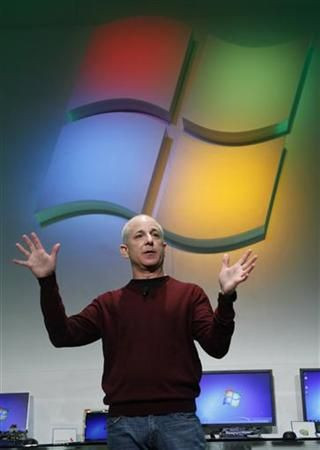Microsoft Lines up its Big Swing at Tablets

Next week a high-ranking Microsoft Corp executive will stand on stage and show off a new version of Windows on a tablet computer.
It won't be the first time. Chief Executive Steve Ballmer did it last year. Co-founder Bill Gates did it 10 years ago.
This time, when Windows chief Steven Sinofsky shows off an early version of its next touch-enabled, tablet-friendly operating system -- code-named Windows 8 -- to independent developers at their annual conference in Anaheim, Calif., next Tuesday, there is a sense that it really matters.
It's a big deal, said Todd Lowenstein, portfolio manager at HighMark Capital Management, which holds Microsoft shares.
Investors are hungry to see how they are going to join where the market's going. They've been lagging and they need to catch up and surpass what's going on, to demonstrate they truly are an innovative company.
Despite foretelling the tablet revolution a decade ago, Microsoft is last off the blocks with a salable device. The tablet PC Gates unveiled at the Comdex tech show in November 2001 was too clunky to catch on. The slick-looking Hewlett-Packard prototype slate brandished by Ballmer at the Consumer Electronics Show in 2010 did not even make it onto the shelves.
The first generation of touch-enabled tablets running Windows 8 are expected on the market in about 12 months.
That gives Apple Inc two and a half years head start with its iPad, which has already sold 29 million units. Tablets running Google Inc's Android software will also have gained ground, likely boosted by an expected Amazon.com device.
The shift away from desk-based PCs -- which mostly run on Microsoft software -- toward tablets and smartphones is happening quicker than expected. The future of Microsoft, and its moribund stock, may hinge on how well Sinofsky can sell the latest combination of tablets and Windows.
Windows 8 might actually matter if they can do the touch-screen innovation, said Michael Yoshikami, chief executive of fund manager YCMNET Advisors. Otherwise Windows 8 is just Windows 7 with one more number.
HEARTS AND MINDS
First, Microsoft needs to get itself back in tune with developers and entrepreneurs who are flocking from Microsoft-centric programing platforms to the more exciting realms of Apple and Android.
The shift to an Apple-based culture is noticeable among innovators and entrepreneurs, said Matt McIlwain, managing director at Seattle-based venture capital firm Madrona Venture Group.
Five years ago I would have said 80 percent of the startups or ventures who came to pitch us pulled out their laptop and started showing us their PowerPoint presentation, said McIlwain. Now 80 percent pull out their Mac. If I were Steve Ballmer, that would be concerning to me.
The enthusiasm of independent software developers is key for the health of what Microsoft calls its Windows ecosystem. It has stirred excitement with its new motion-controlled Kinect system for the Xbox game console, but is lagging in the exploding market for mobile apps.
Apple iPhone and iPad users can download 425,000 apps, while Android users have a choice of 250,000. There are only 30,000 apps for Windows Phones, although that is expected to grow when Microsoft launches its own app store with Windows 8.
Microsoft finds itself playing only a background role in many tech-savvy startups, such as fashion site StyleCaster, which uses Apple computers, Google e-mail, Linux Web systems and Amazon.com Inc for its data storage.
In the last four or five years, ever since the iPhone platform came out, you have even more developers who have moved over onto Apple systems, and that's created more and more tools, said Drew Butler, StyleCaster's vice president of technology.
Not everyone is so downbeat. Wes Greene, lead mobile developer at Seattle-based Groundspeak, which makes a leading app for geocaching -- basically GPS-enabled treasure hunting -- for Windows, Apple and Android phones, expects Microsoft's deal with Nokia to bring it into the mobile mainstream.
He likes what he has read so far about Windows 8.
It's kind of cool to see it's not like three separate companies any more, it's all falling into line.
WALL STREET RESTIVE
Microsoft also needs to connect with Wall Street and investors, who are nonplused with a share price that hasn't budged in the past decade.
Next Wednesday, Ballmer and his top lieutenants are set to make their annual presentations to analysts, in the midst of the developer conference, to explain their strategy.
Analysts will likely focus on the perennial issues -- how long Microsoft should persevere with its massively money-losing Bing search business, and what it should do with its $53 billion cash pile.
Ballmer may also need to address a rising tide of protest from unhappy shareholders, including influential hedge fund manager David Einhorn, who has called for Ballmer's removal and demanded the sale of the online services unit -- including Bing -- which has lost more than $6 billion in the last three years.
In addition, a letter from an anonymous investor to Microsoft's lead independent director was widely circulated over the summer, calling for the company to issue $40 billion of debt to fund a massive share buyback and to direct all its domestic cash flow toward paying dividends, which might increase the share price by more than 50 percent.
Some are hoping for a repeat of Microsoft's special dividend in 2004 which handed back more than $30 billion to shareholders. At the very least, most investors are looking for an increase in Microsoft's dividend later this month, from the 2.5 percent dividend yield it sits at now.
Whether through innovation or financial engineering, investors are looking for Microsoft to show it has more value than its $26 share price -- nine times expected earnings -- indicates.
The stock is reflecting a no-growth, or ex-growth kind of multiple, said Lowenstein. Their hurdle is to convince investors this is not the case.
(Editing by Bernard Orr)
© Copyright Thomson Reuters 2024. All rights reserved.





















